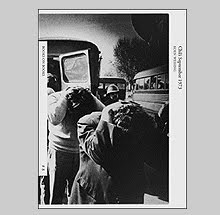Westward the Course of Empire by Mark Ruwedel

Mark Ruwedel's survey of defunct railways that enabled expansion into the American west acts like a walking tour of the past idea of manifest destiny. Each as formally similar to the next, they plod along with an endless horizon drawing us to a destination of promise. Desert turns to prairie back to desert to forest. The stillness of the photos are always like starting points whose long expanses beg to be walked.
Ruwedel photographed these decayed rail beds, tressel bridges, rail tunnels and track cuts through mountain passes over twenty years in the America and Canada with a large format camera. A new book Westward the Course of Empire has just been published by Yale University Art Gallery.
Ruwedel's approach is one of repetition that instantly draws to mind the Becher's systematic documentation. Formally they draw your attention to the remnants of track paths that scar the landscape and finally force acknowledgment of the horizon. Each path holds the promise of progress yet the neglect has allowed the earth to reclaim and impede. One starts to reflect on the single-minded might necessary to cut such swaths through mountain passes in order to continue westward.
The mountain cuts where solid rock was blasted out of the way evoke Timothy O'Sulivan's work in Canyon de Chelly and Black Canyon with their solid white skies that become an additional puzzle pieces that complete shapes of light and dark. Not quite as rigid as the Becher's, Ruwedel allows clouds to appear within the fields of solid, light grey sky.
Westward the Course of Empire is divided into three sections according to type of rail cut or structure. On the facing pages is a handwritten caption which records the name of the original railway. Nevada Short Line, Comox Logging and Railway Company, Denver and Rio Grande Western, Columbia and Western, Spokane Portland and Seattle and the famed Northern Pacific - all names that seem to lay claim to not just the railway but all of the surrounding territory.
The third section which features exquisitely engineered tressels and bridges whose purpose was to provide the shortest possible line from point a to b. They fill in valley drops with a wall of criss-cross patterns as tall or taller than the tree growth that originally provided the material for them. It is within this section that Ruwedel sometimes breaks his formalist method with different picture constructions. Seeing these makes me wish he varied his perspectives all along. As beautiful as the photos are in the first two sections with their lush tonalities, the formal constraints begin to wear thin for me. Perhaps I am missing a deeper metaphor implied as the railways are constrained forms themselves but still, the descriptive freedom allowed to Ruwedel makes me wonder what more could have been done.
As a book Westward the Course of Empire couldn't be better produced. Perfect tritone plates with separations by Thomas Palmer and printing by Meridian in Rhode Island. The cloth and material are not only elegant but preserve the tone of the subject from the tipped-in plate on the front to the decision to place the book's title on the rear cover. 3000 copies were made with 60 copies which come signed and with a print.



























